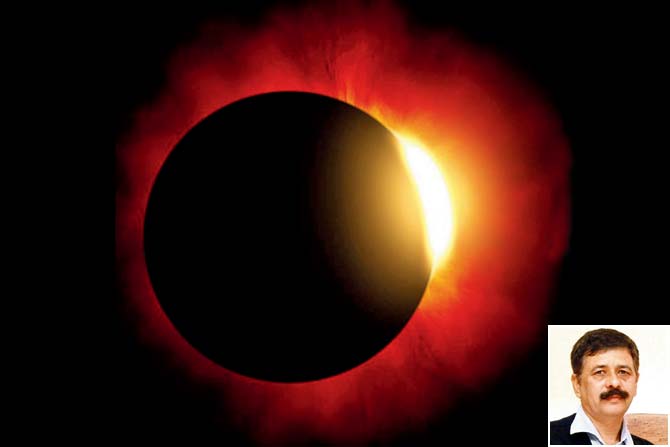18 August,2017 05:05 PM IST | Mumbai | Gaurav Sarkar
City-based scientist Arvind Paranjpye, who is set to witness his sixth solar eclipse from Idaho, US, hopes to decode the celestial occurrence with new study


A solar eclipse in progress. File pic. (inset) Arvind Paranjpye
Even as popular myth surrounding the solar eclipse hails the once-in-a-lifetime celestial event as inauspicious, one curious scientist has been chasing this phenomenon for the last four decades. On August 21, Arvind Paranjpye, who is now the director of Nehru Planetarium, will bear witness to yet another social eclipse -- his sixth since 1980 -- from Idaho in the US, where he will be studying the shadow bands, as well as the solar corona of the sun. "For the last 39 years, I have been watching eclipses from different places," said Paranjpye.
He viewed his first total solar eclipse from India on February 16, 1980, followed by another one that occurred on October 24, 1995. These were followed by eclipse viewings from Iran in 1999, Africa in 2002 and China, 2009. Since the eclipse won't be visible from the Indian subcontinent, Paranjpye decided to travel to Irwin, Idaho this year. "The upcoming eclipse is fairly long and will last for about 120 seconds. The weather is expected to be clear in the US, and this will ensure good visibility," he said.
Studying the phenomenon
While Paranjpye admits being fascinated with the solar eclipse, the real purpose behind the viewings is to understand the phenomenon better. This time around, Paranjpye will be attempting to record three phenomena associated with the solar eclipse - shadow bands, solar corona, and the chromosphere.
Shadow bands occur when light from the crescent sun passes through the atmosphere of the earth. Paranjpye will try and video-record these bands. The solar corona refers to the external atmosphere of the sun, and Paranjpye will attempt to take images from three different angles. He will also be attempting to record the thin atmosphere called the chromosphere. "Recording the spectrum of the chromosphere is important as Helium was discovered here for the first time," he said.
Busting age-old myths
Acknowledging that solar eclipses have invited the wrath of soothsayers and superstitions for eons, Paranjpye clarifies that there is nothing negative about this celestial occurrence. "During the 1980 eclipse, when I was a college student, I ate food and drank water through the eclipse - things that people would advice against," he said. "Yet today, I am the director of a planetarium. It is only the hard work that takes you forward in life."